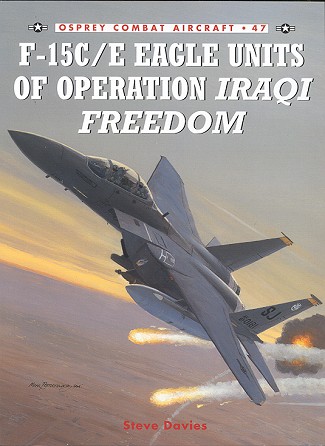 As in Desert
Storm, the most prolific USAF fighter in Operation Iraqi Freedom. This was
because the US was hamstrung by the inability to base as many aircraft in
Saudi airfields as in the previous war. This was mostly due to the
political decision of the US to basically go it alone and start the war,
unlike the earlier conflict where there was aggression on the part of the
Iraqis. Agree with the situation or not, once the civilians start
something, it is up to the military to finish it.
As in Desert
Storm, the most prolific USAF fighter in Operation Iraqi Freedom. This was
because the US was hamstrung by the inability to base as many aircraft in
Saudi airfields as in the previous war. This was mostly due to the
political decision of the US to basically go it alone and start the war,
unlike the earlier conflict where there was aggression on the part of the
Iraqis. Agree with the situation or not, once the civilians start
something, it is up to the military to finish it.
Though there were no air to air victories (that I know of)
coming out of Operation Iraqi freedom, this did not mean that there was not
a lot of danger. This was mostly from ground based AAA and SAMs as well as
the ever-present small arms fire should an aircraft get low enough for
ground troops to take a shot. This danger even included friendly fire as
two Coalition aircraft were downed by US Patriot Missile batteries.
The author has several F-15 books to his credit and while
that means a level of expertise that is commendable, it also means that the
book is full of jargon, abbreviations and acronyms. Though each unfamiliar
item is explained the first time it is used, for those of us who are either
not used to it, or have forgotten much of it after retirement, it makes for
a difficult read. The other side of the coin is that those who are used to
these things will find the book to be easy sailing. I also got the feeling
that the author had to include quite a bit of background stuff to fill the
96 pages just because OIF (Operation Iraqi Freedom) was such a short
conflict without any of the air to air action the we all love to read
about.
It starts off with a general introduction to the F-15 and
what lead up to the current versions in service, including all the current
aircraft systems. Unlike aircraft of old, it is aircraft electronics
(avionics) that are the key to the success of a modern fighter. Sure, the
airframe has much to do with it, but with out the avionics, it just isn't
as capable as it could be.
There are the usual 'there I was...' stories as well as a
feel for what it was like to operate aircraft in the environs above Iraq. A
lot of space was taken with telling about getting the units in place and
the problems of overcrowding at the bases which had to be used. The book is
enhanced by a lot of color, something one rarely has in books on WWII.
There are the usual profiles of grey F-15s as well as several pages of very
nice color close-ups of the nose art applied to the aircraft during the
war.
The appendices include a full serial listing of the Eagles
that took part in the conflict as well as their parent units. Also in there
are nice three view drawings of the C and E model.
Despite my difficulty in following things due to the
jargon, I'd have to say that overall, it is a very well done book and one
that Eagle fans should have on their bookshelves.
Available in bookstores everywhere, through Classic
Motorbooks at (800) 826-6600 or at
www.motorbooks.com. For more on the complete line of Osprey books,
visit www.ospreypublishing.com
If you would like your product reviewed fairly and quickly by a
site that has over 250,000 visitors a month, please contact
me or see other details in the Note to
Contributors.
 As in Desert
Storm, the most prolific USAF fighter in Operation Iraqi Freedom. This was
because the US was hamstrung by the inability to base as many aircraft in
Saudi airfields as in the previous war. This was mostly due to the
political decision of the US to basically go it alone and start the war,
unlike the earlier conflict where there was aggression on the part of the
Iraqis. Agree with the situation or not, once the civilians start
something, it is up to the military to finish it.
As in Desert
Storm, the most prolific USAF fighter in Operation Iraqi Freedom. This was
because the US was hamstrung by the inability to base as many aircraft in
Saudi airfields as in the previous war. This was mostly due to the
political decision of the US to basically go it alone and start the war,
unlike the earlier conflict where there was aggression on the part of the
Iraqis. Agree with the situation or not, once the civilians start
something, it is up to the military to finish it.